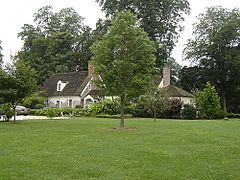Wye House facts for kids
|
Wye House
|
|

Wye House mansion, seen from the front lawn
|
|
| Lua error in Module:Location_map at line 420: attempt to index field 'wikibase' (a nil value). | |
| Nearest city | Easton, Maryland |
|---|---|
| Built | 1784 |
| Architect | Key, Robert |
| Architectural style | Georgian, Federal |
| NRHP reference No. | 70000264 |
Quick facts for kids Significant dates |
|
| Added to NRHP | April 15, 1970 |
| Designated NHL | April 15, 1970 |
Wye House is a very old and important home located near Easton, Maryland. It's a large house that was once the main building of a huge farm called a plantation. Built between 1781 and 1784, it shows a classic style of Southern homes from that time. Today, it is recognized as a National Historic Landmark, which means it's a special place in American history.
Contents
A Look Back at Wye House
Early Days of the Plantation
The Wye Plantation began in the 1650s. It was started by Edward Lloyd, a wealthy man from Wales. He was a Puritan, a type of Christian.
The main house you see today was built much later, between 1780 and 1790. Edward Lloyd IV, a great-great-grandson of the first Edward Lloyd, had it built. The money for building this large house came from the hard work of enslaved people. The house shows a mix of Georgian and Federal architecture styles. A builder named Robert Key is thought to have designed it.
Special Garden Building
Near the main house, there is a special building called an orangery. This building was used to grow orange and lemon trees. It's rare to find such an old garden structure still standing. It even has its original heating system from the 1700s, which used hot-air ducts.
Life on the Plantation
At its largest, the Wye Plantation was huge. Its owners forced over 1,000 people to work on the land. The plantation covered more than 42,000 acres (about 17,000 hectares). Today, the land is smaller, about 1,300 acres (526 hectares). But it is still owned by the same family, the descendants of Edward Lloyd. They are now the 11th generation to live there.
Frederick Douglass, a famous writer and speaker, was enslaved on this plantation. He lived there when he was about seven or eight years old. In his book, Narrative of the Life of Frederick Douglass, an American Slave, he wrote about the very harsh conditions on the plantation.
Wye House Today
Descendants and Community
The nearby towns of Unionville and Copperville are home to many people today. These people are descendants of those who were enslaved at Wye House. This means that the families of the original owners and the families of the enslaved people live very close to each other.
Digging Up History
In 2006, Wye House became famous for its archaeological digs. The University of Maryland led these investigations. Archaeologists study old objects to learn about the past.
In 2011, they dug up the greenhouse, which enslaved African people had built. They found something amazing: African charms. These charms were placed near the house's furnace and entrance. People believed they would protect against bad spirits. This discovery helped us learn more about the lives and beliefs of the enslaved people at Wye House.


